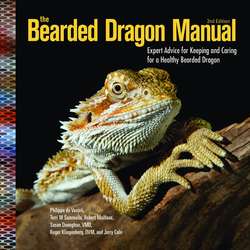Читать книгу The Bearded Dragon Manual - Philippe De Vosjoil - Страница 3
На сайте Литреса книга снята с продажи.
ОглавлениеINTRODUCTION
Inland bearded dragons have been called the perfect reptile pets—for good reason. They are typically tame, easy to keep, and relatively hardy, and they come in an array of stunning colors. Bearded dragons are also amusing, intelligent, and endearing, so it is easy to understand why they are—and have been—one of the most popular reptile pets of all time. For people with fur allergies, a bearded dragon is often a wonderful alternative. They do, however, have certain requirements, as with any pet. And that is where this book comes in.
When I was asked to update The Bearded Dragon Manual, I was thrilled to be able to offer an additional perspective: that of an indoor breeder of exclusive high-color dragons. During my many years as a wildlife rehabilitator and working at the Baltimore Zoo (now the Maryland Zoo), I had the opportunity to learn behavioral-observation skills and large-collection management techniques. I am very grateful to longtime friend Dr. Thomas Ryan, DVM, and the other brilliant folks along the way who taught me to observe behaviors and then draw conclusions based on those observations.
It is my intent to add to the fine work of authors Phillippe de Vosjoli; Robert Mailloux; Susan Donoghue, VMD, DACVN; Roger Klingenberg, DVM; and Jerry Cole with easy-to-understand, practical information about general husbandry, updated views on topics such as feeder insects, tips and answers to common questions, and my personal observations from more than fifteen years as owner of Fire and Ice Dragons. In short, I hope to make the additional information on caring for bearded dragons easily accessible to the pet owner and new breeder. And you can also count on gorgeous photos of the newest color morphs.
Bearded dragons are attractive in appearance, moderately sized, naturally tame in demeanor, and very personable (by reptilian standards). Being ectotherms (cold-blooded), they have particular requirements that differ significantly from those of more traditional pets, such as dogs, cats, and birds. We warm-blooded humans don’t always have a natural propensity for understanding the care of reptiles, but compared to many other reptiles, bearded dragons are relatively hardy and easy to keep. Successfully keeping bearded dragons depends on developing basic knowledge of their needs and acquiring the supplies and technology to care for these beautiful lizards.
Much of this information in this version of the book has never before appeared in print. We hope that this information will improve your understanding of bearded dragons’ life stages and, in turn, help you ascertain the best way to provide for their health and well-being. It is obvious that, like humans, bearded dragons undergo periods of growth and changes in behavior, which may require the dedicated owner to adjust his or her methods of husbandry to meet the needs of each life stage.
Much work still needs to be done with these lizards in a wide range of areas, including nutrition, herpetological medicine, and genetics. There also remain critical obstacles that have yet to be overcome, such as identifying the factors that have prevented the long-term captive keeping and breeding of Lawson’s dragon and the Eastern bearded dragon. These challenges and promises of an ever-more-exciting future continue to drive us into the peculiar passion called herpetoculture! All in all, it is an exciting time to be involved in the evolution of herpetoculture, and we welcome you to the hobby.
—Terri M. Sommella
